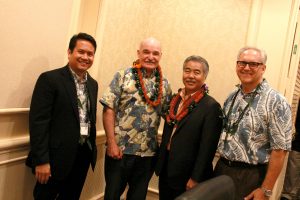Hawai’i’s clean energy future
Posted on Jun 30, 2016 in Main
From biomass and solar to wind, wave, geothermal and hydroelectric, the islands offer a natural test bed of possibilities to help the state reach its goal of 100 percent clean energy electrical generation by 2045. To reach that goal, a whole energy ecosystem is being developed in the islands involving utilities, researchers, policy-makers, state, county, and federal agencies, investors and entrepreneurs who want to contribute to a clean energy future. (For a state map of 60 renewable projects, go to https://1.usa.gov/28QdBHz.)
As an electrical engineer who understands the issues and what’s at stake, the governor has made his vision clear. “Part of being governor is to see the opportunities and challenges,” he said in an earlier interview. “We need to set goals that are aspirational, but not so far out of reach that the goals become useless.”
He cites the $5 billion the state has been spending yearly on imported fossil fuel — funds that could help our community through clean energy’s “triple bottom line” of more local jobs, lower consumer costs and environmental benefits. He’s also aware of the skeptics and the technological hurdles that need to be overcome to reach the state’s clean energy goals.
But he and others are quick to point out the advances being made right here in Hawai‘i that are paving the way to the future. Mark Glick heads the Hawaii State Energy Office (HSEO), charged with driving the state’s clean energy agenda through policies, programs and public-private partnerships.
His office, under the state Department of Business, Economic Development and Tourism, coordinates efforts on everything from clean transportation and encouraging use of electric cars to recognizing “green” businesses and connecting consumers, developers and investors with resources for clean energy projects and improvements.
HSEO also is launching what Glick calls “a new method of planning under the Ige administration,” bringing together progressive planners and Hawaiian Electric (HECO) engineers early in the process to align utility planning with state clean energy policy. “They’re working as a team to figure out ways to ramp up renewables without overbuilding or creating too much cost for the ratepayer,” said Glick. “The federal Department of Energy is watching this process and believes it could be a model for the nation.”
New test-bed ventures are under way on nearly every island as well as commercial, utility-scale operations such as solar and windfarms, biomass and hydroelectric plants and geothermal. Also, HECO has announced plans to roll out “smart grid” technology on O‘ahu, Hawai‘i Island, and in Maui county to help customers control their electric bills while the Kaua‘i Island Utility Cooperative plans to use similar smart metering for energy efficiency.
DBEDT director Luis Salaveria underscored the importance of Hawai‘i leveraging all these areas in its role as an energy innovation leader. “We’re excited to bring together some of the brightest minds in clean energy to find sustainable solutions for the future.”
###
Photo: Group shot of Gov, Luis, Asst. Navy Secretary and Mark Glick